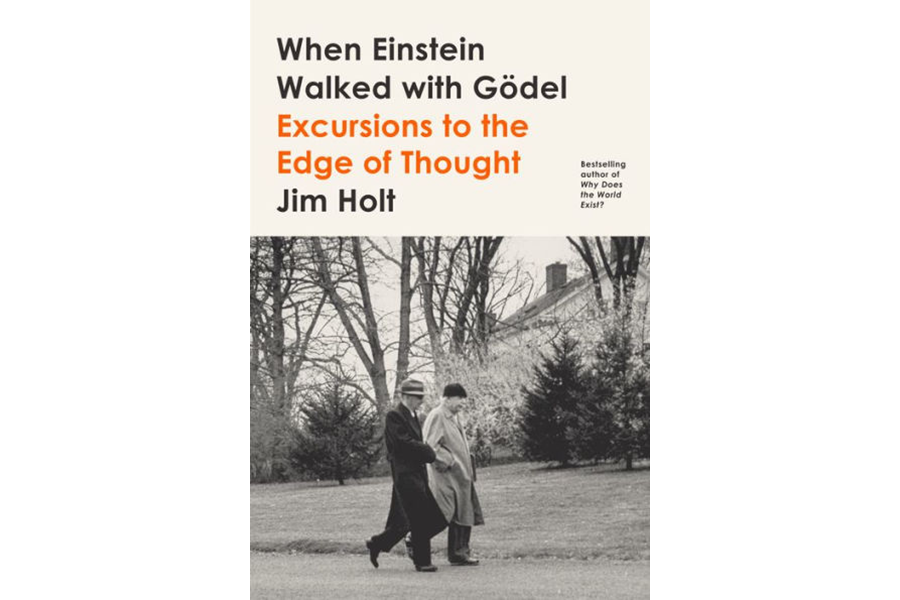'When Einstein Walked with Gödel' is science writing at its best
Loading...
The walks referred to in science writer Jim Holt's new book When Einstein Walked with Gödel: Excursions to the Edge of Thought happened near the gorgeous campus of Princeton University in the 1940s, when Albert Einstein, by then one of the most famous and visibly recognizable scientists in the world, would share his walks home with Kurt Gödel, the much-younger titan of conceptual higher mathematics. Fellow members of Princeton's Institute of Advanced Study usually looked at these peripatetic conversations only from a distance; one of those members, the physicist Freeman Dyson, commented that Gödel was “the only one of our colleagues who walked and talked on equal terms with Einstein.”
And yet, as Holt points out, both men were effectively relics; their fields had in many ways evolved beyond their landmark contributions. Gödel's view of mathematical abstractions was seen as slightly silly and eccentric even in his own lifetime, and Einstein had famously if fruitlessly contended with the implications of quantum theory elaborated by scientists like Niels Bohr and Werner Heisenberg.
Even Holt's fleeting mention of these factors provokes deep curiosity about these Princeton conversations and the two men who held them, but despite its title, "When Einstein Walked with Gödel" isn't a more-than-350-page account of the personal and professional world of Einstein and Gödel (Palle Yourgrau's 2005 book "A World without Time" does that superbly), nor is it a book-length study of Einstein's time at Princeton (chunks of 1987's "Who Got Einstein's Office?" by Edward Regis do this with entertaining energy). Instead, Holt's book is much closer to a series of dispatches about the larger scientific world Einstein and Gödel inhabited.
These dispatches were all originally published elsewhere, in bookish journals like The New York Review of Books ("When Einstein Walked with Gödel" is dedicated to Bob Silvers, the NYRB's late legendary editor), The London Review of Books, and The New York Times Book Review, and they all wonderfully achieve Holt's stated goal: “to enlighten the newcomer while providing a novel twist that will please the expert.” This is considerably more difficult than it sounds, and Holt does a beautifully readable job.
Perhaps to the dismay of his lay readers, “beautiful” is a word that crops up frequently in these pieces, usually connected with … math. For people who've learned something of higher mathematics, “nothing could be more natural than to use the word 'beautiful' in connection with it,” he contends. “Mathematical beauty, like the beauty of, say, a late Beethoven quartet, arises from a combination of strangeness and inevitability.” Even at the hands of an expert popularizer like Holt, that beauty can be elusive, probably for simply biological reasons. “The fundamental problem with learning mathematics,” Holt writes, “is that while the number sense may be genetic, exact calculation requires cultural tools – symbols and algorithms – that have been around for only a few thousand years and must therefore be absorbed by areas of the brain that evolved for other purposes.”
The inviting tone of this goes a long way to compensating for this potential comprehension gap. Whether Holt is writing about historical figures like Isaac Newton, Ada Lovelace, and Alan Turing or speculating on much more recent concepts like string theory, or the ultimate fate of the universe, about which our author is sanguine: “For all of the fascinating theories and scenarios they spin out, practitioners of cosmic eschatology are in a position very much like that of Hollywood studio heads: nobody knows anything.”
He returns repeatedly to the alleged wonders of mathematics, calling higher math “beautiful” so regularly that you almost start to believe it, asserting things like “the space we actually live in might seem boring in comparison with the rococo spaces of higher mathematics,” and so on. And his piece here on the implications of quantum mechanics that so disturbed Einstein is a highlight of the book, a marvel of short-form lucidity in attempting to explain the inexplicable. “Einstein, 'Spooky Action,' and Space” takes readers quickly but authoritatively through a breakdown of the concept of quantum “entanglement,” where two subatomic particles seem to share states of alignment despite any amount of distance between them – seemingly violating some of the basic tenets of relativity on which Einstein's reputation is based.
Science writing of the caliber on display in "When Einstein Walked with Gödel" is a boon in these times of looming scientific illiteracy. Holt makes his recondite subjects seem not only fascinating but fun, humanity's greatest intellectual adventure – and one that badly needs as many adventurers as it can get.








